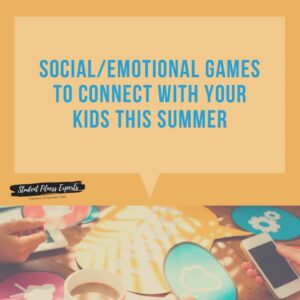Social-emotional and Self-awareness games
It has been awesome playing with you this summer! With all the different games and activities we have shared, you may have noticed a common theme…? While we are physically working the body through balance, spatial awareness, throwing, catching, etc, we are always working on social-emotional skills. How kids handle successes, challenges, stressors, frustrations, teamwork, leadership, and connection all stem from their ability to be socially and emotionally intelligent. This week we’re going to focus on building and supporting these skills directly.
Social-emotional games can help kids learn to manage their feelings and emotions in a fun and relaxed setting. Self-awareness, positive relationships, empathy, self-control, conflict resolution, and positive choices extend beyond gameplay, supporting kids in thriving successfully throughout their lives.
5 Key components of Social-Emotional Learning (casel.org)
Self Awareness – The abilities to understand one’s own emotions, thoughts, and values and how they influence behavior in various situations.
Self Management – The abilities to manage one’s emotions, thoughts, and behaviors effectively in different situations and to achieve goals and aspirations.
Social Awareness – The abilities to understand the perspectives of and empathize with others, including those from diverse backgrounds, cultures, and contexts.
Relationship skills – The abilities to establish and maintain healthy and supportive relationships and to effectively navigate settings with diverse individuals and groups.
Responsible decision making skills – The abilities to make caring and constructive choices about personal behavior and social interactions across diverse situations.
1. Body part tag (Improves hopping, crawling, agility, hand-eye coordination, spatial awareness, resilience, and self-management)
a. Set up your playing field – this game is best played in an open space, but doing it in your living room and having to jump and climb over furniture certainly adds an additional element of challenge and fun! Use cones, chairs, sticks or any other big or bright object to define the boundaries if playing in open space.
b. In this game only the arms and legs can get tagged.
c. Once an arm or leg is tagged the player “loses” that limb.
- Arms go behind the back
- Lose one leg – you can hop on the other leg
- Lose both legs – you can walk on your knees, crawl and use one hand if you have it, scoot on your bottom or another creative solution!
d. There are 2 ways to play:
-
- There is one (or 2) tagger(s)
- Tagger(s) runs around trying to tag everyone’s arms and legs.
- Once a player loses all their limbs, they go out of the playing and do something active (throw and catch a ball, kick/trap/shoot, jumping jacks, etc)
- Everyone is it
- Everyone can tag everyone.
- Once you lose all your limbs you have to leave the playing and do something action either for a certain count, distance or for time (10 starfish jumps, bear crawl the length of playing field/across the living room, or 30 second quick feet)
- When you’ve completed the active task you return to the game with all of your limbs.
- In this version, you may want to set a timer so the game is played for 10 minutes. If you want to define a winner, you can count how many times a player had to leave the field because they lost all their limbs.
- There is one (or 2) tagger(s)
e. For younger players, you can do arms only and then they can tag with their feet and if they want their arms back, they can do one of the actions.
d. For older players, you can make the actions more challenging, change the size of the playing field, or change up the taggers mid round (if doing only 1 or 2 taggers) to work on listening skills
2. Scarf/sock tag (Improves agility, hand-eye coordination, spatial awareness, resilience, social awareness, as well as responsible and quick decision making)
- Gather your materials – you need anything that is long and durable such as scarves, bandanas, tube socks, flag football flags, cut up old t-shirts or sheets)
- Set up your playing field – this game is best played in an open space, but doing it in your living room and having to jump and climb over furniture certainly adds an additional element of challenge and fun! Use cones, chairs, sticks, or any other big or bright object to define the boundaries if playing in open space.
- You’re going to tuck your scarf (or sock) into your waistband so there is a long enough section sticking out so it can be grabbed safely.
- You can use as many as you’d like, we like to start with 3 per person and then you can go up from there.
- Everyone is “it” in this resilience and quick-thinking game.
- Each player is trying to take the scarf (or sock) from every other player.
- Once a scarf has been taken, the new owner tucks it into their waistband (so now they would have 4 and the other player would have 2)
- There are no “outs” in this game, it doesn’t matter if you are out of scarves, you can continue to take from others.
- The great thing about this game is that you have to play offense and defense at the same time, so while you’re trying to take someone else’s scarf, you have to make sure no one is taking yours!
- Optional rules:
-
- Set up a designated area for kids to place new scarves in their waistband (best to put a 10-second time limit). Remind other kids that they are not allowed to stand there and wait for them to come back into play.
- Only 1 scarf is allowed to be taken at a time. If multiples are removed, all but 1 are to be given back.
-
- Best to place a timer on this game for 10 minutes
- This game may result in some body bumps so remind kids to play kindly and only reach for the scarves at the waistband.
3. Guess the feeling/emotion (Improves self-awareness, social-awareness, relationship skills, and behavioral control)
- Gather your materials – you will need index cards or cut up pieces of paper about the same size and a marker.
- Write 1 emotion or feeling on each of those cards/papers
- One child will pick a card and then act out that feeling/emotion and the other kids (or you or another awesome adult) will guess the feeling/emotion they are trying to convey.
- You can then have a short conversation about how you knew that was the feeling/emotion they were experiencing and in what type of circumstances they may have that feeling/emotion.
4. Partner/team move it, move it (Improves social awareness, relationship skills, proprioception, planning, sequencing, and organizational skills)
-
- This game is basically about moving things from one place to another. You can be as creative as possible with what you move and how you move it!
- Gather your materials
- Use large items – chairs, boxes, planks of wood, large toys, trash can (clean them with a sponge first!), tires, a hose, anything big that maybe has a funny shape or parts to coordinate. Also, try using objects of different weights.
- Use medium or small items – balls, marbles, toys, pillows, socks, cars, anything about the size or smaller than a basketball so you can be creative about how you’re going to get it across the playing field.
- Set up your playing field – this game is best played in an open space, but doing it in your living room and having to climb and maneuver over and around furniture certainly adds an additional element of challenge and fun! Use cones, chairs, sticks, or any other big or bright object to define the beginning and end points of your move.
- Determine how you’re going to move your materials
- With your hands – the large items, you may just want to pick up solo or with your friends/caregiver and move them from the start to finish point.
- With support – for the medium to small items you may want some help so you’re running back and forth 20 times. Try using a sheet, pillowcase, t-shirt, or anything non-conventional (so not a basket or bucket, get creative)
- How you move – challenge your trip with your items by moving in different ways (backward, sideways, crawling, crawling backward or sideways, jumping, hopping, rolling…)
- For younger children, continue to challenge what they’re moving and how they’re moving it.
- For older children, you can make it a competition – who can get their items over the fastest or who can get the most items over in a certain period of time. You can also make it a relay.
5. Build it (Improves self-management, social awareness, relationship skills, planning, sequencing, and organizational skills)
-
- Gather your materials – you can use typical items such as blocks and legos, etc or you can get more creative using recycled items such as cardboard or cereal boxes or any other empty food container (milk, fruit, cheese, snacks, packaging). Toys, pillows, empty toilets,s or paper rolls also make for great building materials.
- Set up your playing field – this can be done on a table, the floor, or on a chair… choosing a unique base will create a challenge from the onset of this activity.
- Challenge your building – will it be tall or short, wide or narrow, square or round, humble or extravagant, fit for animals or people to live inside of it?
- Challenge how you build – sure you can use your hands, but what if you use your elbows, knees, or feet? Or what if you moved everything together with your friend or guardian? So you each had one hand on the item and had to discuss location and place it together.
6. Cut it up (Improves adaptability, creativity, planning, sequencing, organizational skills, teamwork, and leadership skills)
-
- All summer we have been working on a collaborative art project. Now is the time to decide what you’re going to do with this giant activity. Work together with your friends and family members with whom you created your masterpiece and decide if you’re going to cut, tear, rip, roll, or fold it to put it on something completely different, such as decorating a cardboard box, a fence or a wall.

